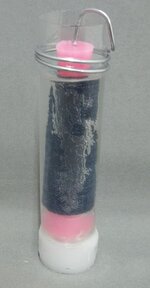pssherman
Member
When doing tube-in casts with silmar 41 do you heat the mold, tube and resin before adding MEKP?
I always heat the resin. I do not use molds because I do mainly vertical casting. The one thing or actually a couple things that are so important to casting of any resins is mixture. Correct formula along with totally mixing and that means scraping of the sides of containers. Have all parts needed including pressure pot ready to go when getting ready for casting so you are not looking around for items. Watch your times before things kick off. I always try not to bite off more than I can chew. better to have left over resin than not enough. Casting takes time to learn and errors do happen. Roll with them and learn. It is only resin.When doing tube-in casts with silmar 41 do you heat the mold, tube and resin before adding MEKP?

How do you apply the resin to the tube inside the sleeve?John can probably give you a more solid answer because he does more casting that I do. But here is my thoughts. I use to get this when I first started also and another member helped me. First thing is when you heat all those parts the resin will kick so much faster. You may not have a chance to get all air out of products such as fabric. or even braidings. I said this once before but I am not a fan of using CA as an adhesive with any resins. other may have no problem so your milage may vary. How I crossed out those things from happening on my sleeve pours like that I use the same resin to adhere the sleeving to tube. I then apply a thin seal coat of that resin to outside of sleeve. This now eliminates any air bubble coming from under the wrap. After it dries I trim sleeving back and set up for casting as normal. But before I put in toaster oven for a few minutes to get stickness off. just my way of doing things. here is a photo of my rack I built. Crude but effective.
View attachment 347759
jt- Can u point me to some info on tube-in casting? I see the stuff on Ptownsubbie but I'm thinking that there must be other methods. Thanks in advance.I always heat the resin. I do not use molds because I do mainly vertical casting. The one thing or actually a couple things that are so important to casting of any resins is mixture. Correct formula along with totally mixing and that means scraping of the sides of containers. Have all parts needed including pressure pot ready to go when getting ready for casting so you are not looking around for items. Watch your times before things kick off. I always try not to bite off more than I can chew. better to have left over resin than not enough. Casting takes time to learn and errors do happen. Roll with them and learn. It is only resin.
I coat the tube with those cheap flux brushes. I hold the tube on a rod such as seen on my rack. I then slide the sleeve over the tube. Center the tube in sleeve and then cinch off with tie wraps as shown in photo. I then place on rack and spread some of that resin which is mixed the same way as a pour but in smaller quantity over the sleeve. I try not to get too far past the sleeve on the tube because it is harder to snap off because it adheres to rod. I like to clean the rods after each use and put a coat of wax on them to help make it easier to pry loose if excess resin gets in between sleeve and rod. I then trim them back close to ends of tubes but leave about 1/16" hangover. That gets sand off when I true up blanks when turning. Been doing it this way for a long time with any type of sleeving material. Works well.How do you apply the resin to the tube inside the sleeve?
Andy, vertical casting is easy and done with a tube system. Johny U has a whole system he sells at Exotics and if you look at the parts and he may even have a video there will show all that is needed. Now this is not new and a few people were doing it before John came out with that system so we all made our own rough jigs but did the trick. His is a cleaned up version. There are also some threads here on this.jt- Can u point me to some info on tube-in casting? I see the stuff on Ptownsubbie but I'm thinking that there must be other methods. Thanks in advance.
Andy
Thanks. I assumed there were threads on here but could not find any.Andy, vertical casting is easy and done with a tube system. Johny U has a whole system he sells at Exotics and if you look at the parts and he may even have a video there will show all that is needed. Now this is not new and a few people were doing it before John came out with that system so we all made our own rough jigs but did the trick. His is a cleaned up version. There are also some threads here on this.
https://www.exoticblanks.com/underhill-vertical-casting-solutions-standard-18.html
https://www.penturners.org/threads/vertical-casting-systems.173133/Thanks. I assumed there were threads on here but could not find any.
